Copyright 2020 - 2021 irantour.tours all right reserved
Designed by Behsazanhost
Abyane the red village
Abianeh or Abyane
One of the most famous Iranian villages, Abianeh is a constant source of admiration for the visitor. It is particularly remarkable for distinctive red-colored houses abutting the steep western slopes of the Karkas Mountains - Kashan. In a bird's-eye view, the village looks like an oblong bowl encircled by a chain of mountains. It is situated 2,100 m above sea level and has a refreshing climate, pleasant in summer and autumn but bitterly cold in winter. Abyane is famed for its beautiful natural setting, peculiar mud-brick architecture, and colorful costumes of women residents.
The name of Abianeh (or Viuneh in the local dialect) means "the place planted with willows". These trees are quite scarce today, but it seems that in olden times the entire gorge was covered with the greenery of willows. Although Abianeh definitely dates from remote antiquity, there is not much evidence of its past. The remains of a fire temple prove the importance of the village during the pre-Islamic period. The Islamic history of Abianeh, especially starting from the Seljuk rule, is more pronounced. To this period belong the Congregational Mosque (dated 1085) and a number of houses.
What to visit around Kashan |
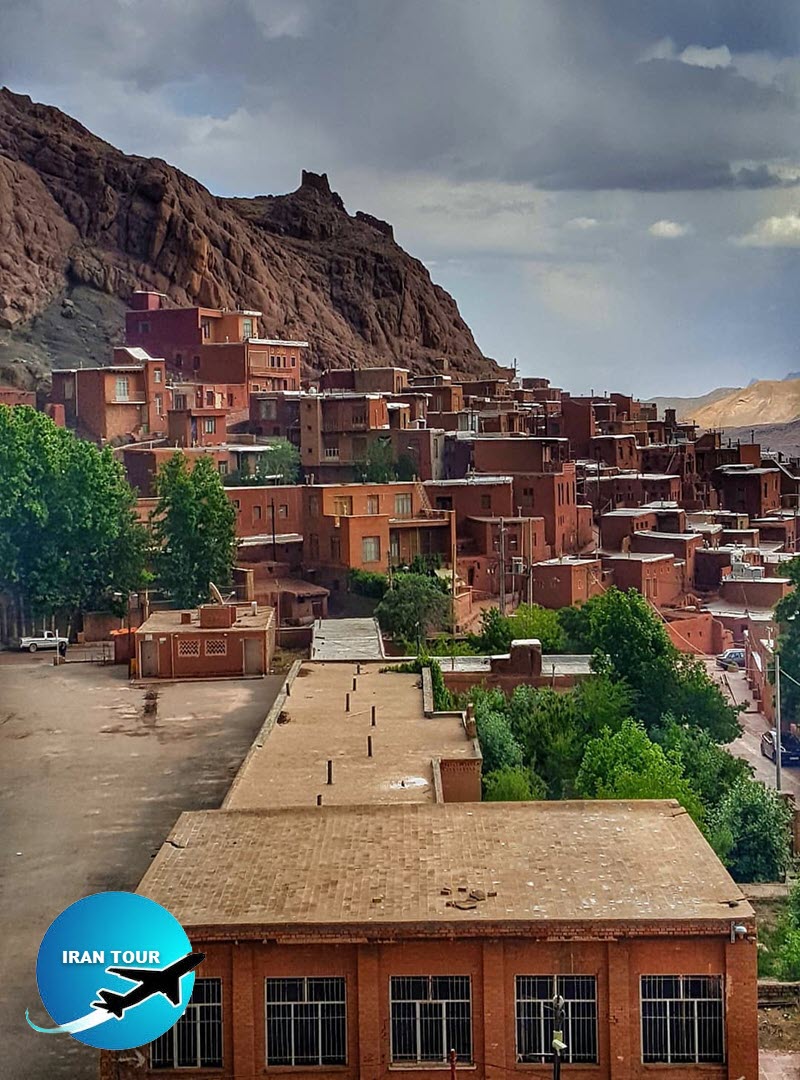 |
Abianeh houses are characterized by a lofty eivan, overlooking the south. This eivan is flanked by two-story living quarters, with winter dwellings occupying the ground floor and summer rooms situated on the upper floor. Service sections are located on the southern side behind the eivan. In many buildings, though they have several floors, there are no stairs, and its owners use a natural incline of the foothill to move between the stories.
Emphasis on exterior features - opposite to the interior-oriented Iranian houses - is the hallmark of Abianeh structures. Several houses from the Seljuk and Il-Khanid periods have survived in the village, and some of them have even preserved the original wooden fretted doors with carved patterns and inscriptions. Of these, the Kohneh (Old) House beside the former Khaneqah is the oldest; its wooden door is dated 1142.
In addition to its numerous architectural amenities, Abianeh is particularly notable as an important ethnographic site. Its pious, tradition-minded people are perhaps the only people in Iran to speak the ancient Middle Persian language in their daily conversations. Until recently, the residents of the village were divided into two social classes - the peasants and the landowners, and there was almost a caste distinction between these two. However, whenever construction was being undertaken in the village, the expenses were divided equally among all the families, rich and poor. The rich, of course, also had to provide the builders' living costs.
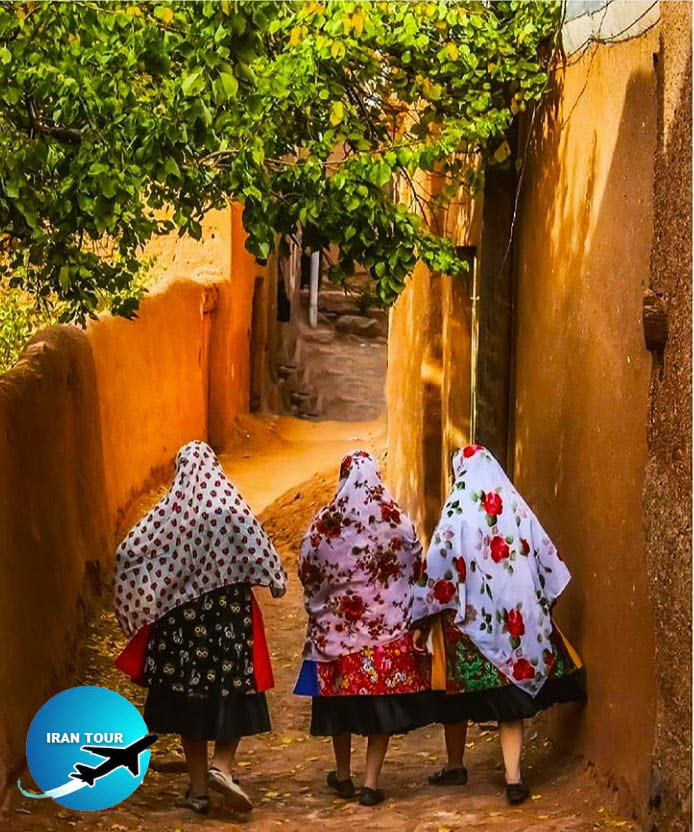 |
Prudence and thrift are perhaps the most characteristic features of Abianeh residents. They are unbelievably attached to their landholdings. It is said that in the past they had an elaborate system of food preservation that allowed them to sell their food to the starving neighboring villages in exchange for land plots. This led to the enormous extension of Abianeh properties, scattered throughout the region and much exceeding in size the area occupied by the village itself. To preserve this property, the Abianeh residents never gave their girls in marriage to an outsider. Land purchases were often commemorated by village festivities, but if the land was for any reason sold, the “traitor" was often treated with bad grace by the others.
The women of Abianeh have always enjoyed equal rights with men - an unusual custom in an Islamic community. Late marriages at the age of at least 30 were common because this practice permitted more effective birth control. Families never had more than three children. There were never polygamous marriages, and the divorce rate was very low, mainly because a divorced woman obtained two-thirds of the family property. Widows never remarried. Women have always worked together with men; that is why handicrafts have not thrived in Abianeh. A distinctive local food is Gipa (a stuffed udder). It is cooked and served on the most special occasions. Sadly, the village is almost deserted today. However, all the natives gather here during the Nouruz festivities and for the Moharram rituals, particularly on Tasua and Ashura days.
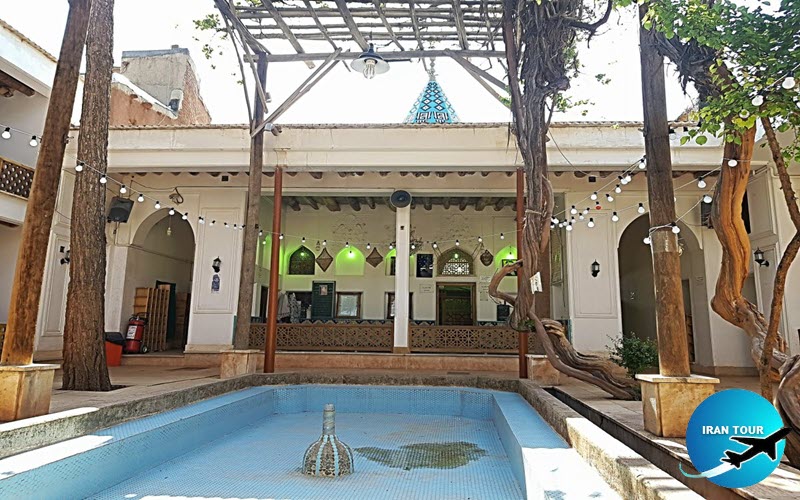 |
-Congregational Mosque
Although quite unremarkable from the outside, the Congregational Mosque of Abianeh has some of the most valuable relics found in Iranian religious buildings. It is entered through handsome inlaid doors, decorated with floral patterns and fine calligraphy. This door was made in 1933 by Safar Ali Bigdeli to replace the broken original door of the structure. The mosque consists of two prayer halls. The one in the basement is very old and is usually closed to the public. Its finely carved wooden mihrab bears the date 1084, indicating the Seljuk origin of the structure. It is the only wooden mihrab in Iran that has survived from this date.
 |
| The old prayer hall of Abyane Congregational Mosque belongs to the Seljuk era |
The prayer hall on the ground floor can be visited around the prayer hours. This hall measures 12 by 6 m. It is lit by a large aperture in the ceiling. The section to the right of the entrance is particularly remarkable. Its beautiful wooden ceiling is divided into squares with elaborately carved and painted ornaments. It is supported by three massive pillars with attractively engraved capitals and shafts. Curiously, the trees from which the pillars were chiseled do not grow in the region and their origin is unknown. The prayer hall features a large fretted minbar made of walnut. It is decorated with floral designs and carved Kufic inscriptions.
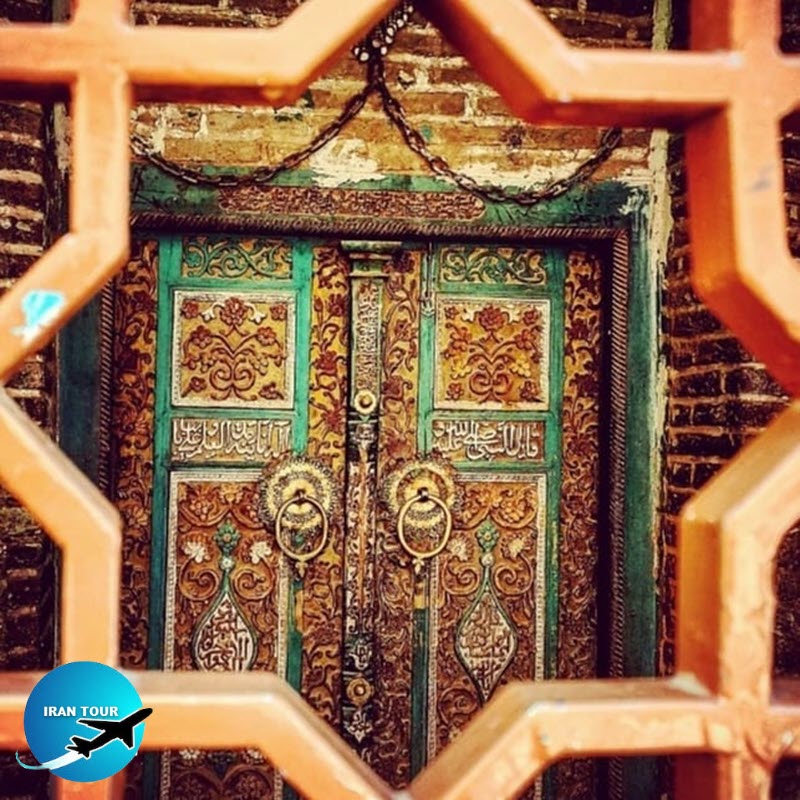 |
-Other historical buildings of Abianeh
The Porzaleh Mosque is originally a Safavid structure, with some minor modifications from the Qajar age. This mosque consists of a prayer hall and an open veranda.
The Hojatgah Mosque is located in the western part of the village. It also dates from the Safavid period. Until recently, the locals brought their sick to this mosque to pray for their recovery, and they still treat this site with particular reverence.
Another religious site of the village - Ziaratgah (pilgrimage site”) - consists of a mausoleum and an open veranda, from which can be seen the remarkable panorama of the village's environs. The mausoleum is said to commemorate the two descendants of Imam Musa al-Kazem, Shahzadeh Yahya and Shahzadeh Isa. It is the only structure in the village that has a conical turquoise roof.
Abianeh features the remains of one of the most important Sasanid fire temples in Iran - Harpak.
The village also has three ruined fortresses and three ancient water mills, one of which still works.
On the Road of Kashan to Isfahan |
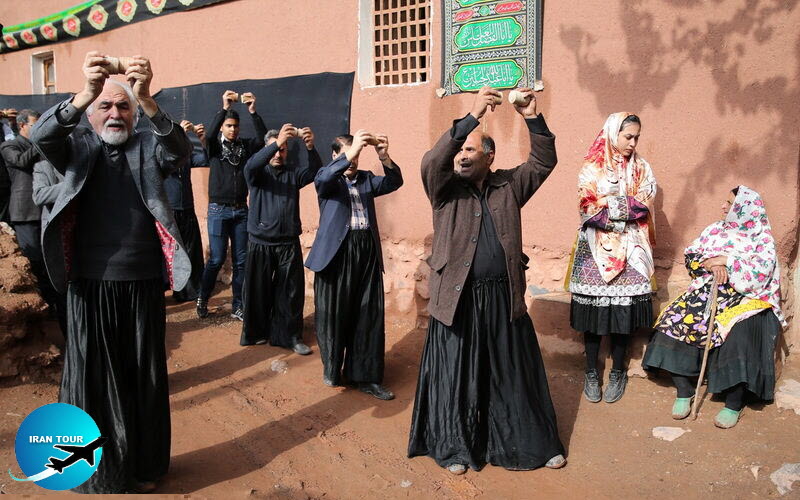 |
-Tasua and Ashura in Abianeh
The days of Tasua and Ashura are commemorated in every settlement throughout Iran, but Abianeh has several special ceremonies that are held here on Moharram 9 and 10. The village becomes very crowded on these days not only because it is a must for every native of Abianeh to return to the village on this day, but also because people from all over Iran gather to watch the Moharram rituals held here. Like in other places, the Moharram ceremonies begin on the first day of the month.
People decorate the mosques and gather there during eight evenings to participate in Rowzehkhani, the ritual of reciting poems commemorating the death of Imam Hossein and his counterparts. The Rowzeh-Khani ritual is often followed by Zanjirzani, when men beat and chain their breasts in the sign of impassioned grief. Tasua opens the series of the most spectacular ceremonies. In the morning, men march along the streets of the village, stopping at the houses of those who had died during the past year. There they read Fatihah - the first sura (chapter) of the Koran - in memory of the deceased. As a rule, relatives of the deceased spread a rug in front of their house to show the marchers where to stop. They often treat the men with tea, dates, and homemade sweets. Men of the Yasman district of Abianeh start Tasua with the Jaqjaqeh ritual. They take the jaqjaqeh - chunks of wood - in their hands and march in two rows toward the Ziaratgah, hitting the chunks in the rhythm defined by the leader of the group who also recites a poem peculiar to the ceremony When the Jaqjaqeh ritual is over, men of this district start the Shaddeh-bardari ceremony. Shaddeh consists of a metal frame wrapped invaluable fabric. It is carried through the streets at the head of the procession and put on the ground in front of every house where someone died in the last year. With this, the first part of the ceremony is over, and the marchers gather in front of two of the village's Hosseinivehs to prepare for carrying the Nakhl, a ritual standard. By this time, the Nakhl is richly decorated and is ready for carrying out. It is placed on the poles that several men of the village put on their shoulders. One person climbs on the top of the structure and directs the procession. The right to carry Nakhl, and particularly to direct the procedure is hereditary. On this day, Nakhl is carried through the streets at the head of the procession and is put on the ground only once when the marchers have the dinner that is distributed free to all the village guests. In the evening of Tasua, men again participate in Rowzeh-Khani. This time lasts throughout the entire night and ends with the communal morning prayer. On Ashura, the ceremony of carrying the Nakhl is repeated with the difference that the marchers stop and put the Nakhl on the ground in front of the houses of those that had a death during the past year. On Ashura, the Nakhl is wrapped in black cloth. The ceremony is over by midday when the Nakhl is returned to the Hosseiniyeh. There its decorations are removed and put into caskets to be taken out the next year. The stripped frame of the Nakhl is also preserved in the Hosseiniyeh. The marchers then go to the Ziaratgah, continuing to chain themselves. After the communal prayer, the ceremonies are over, but people stay in the streets exchanging the news and sharing common meals.
- Details
- Category: Where to go in IRAN